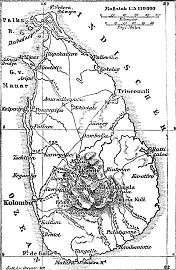Kingdom of Upatissa Nuwara
| Kingdom of Upatissa Nuwara | |||||||||
|---|---|---|---|---|---|---|---|---|---|
| 505 BC–377 BC | |||||||||
| Capital | Upatissa Nuwara | ||||||||
| Common languages | Sinhala | ||||||||
| Government | Monarchy | ||||||||
| King | |||||||||
• 505–504 BC | Upatissa of Upatissa Nuwara | ||||||||
• 504–474 BC | Panduvasdeva | ||||||||
• 474–454 BC | Abhaya | ||||||||
• 454–437 BC | Tissa (King) | ||||||||
• 437–377 BC | Pandukabhaya | ||||||||
| Historical era | Ancient | ||||||||
• Death of Vijaya | 505 BC | ||||||||
• Capital moved to and start of the Anuradhapura Kingdom | 377 BC | ||||||||
| Area | |||||||||
| 65,610 km2 (25,330 sq mi) | |||||||||
| |||||||||
| Monarchs of Sri Lanka House of Vijaya |
|---|
|
| Historical states in present-day Sri Lanka |
|---|
 |
|
1017–1070 |
The Kingdom of Upatissa Nuwara (sometimes referred to as Vijitapura) was the second administrative center in ancient Sri Lanka. It was established with the death of Prince Vijaya by his prime minister Upatissa who became his regent while Vijay's heir to the throne and nephew Panduvasdeva came to the kingdom from North India.
Founding, name and Location
Upatissa Nuwara was seven or eight miles further north of the Kingdom of Tambapanni,[1] which was in a district near modern-day Mannar, and is believed to be the district of Chilaw.[2][3] It was named after the regent king Upatissa, who was the prime minister of Vijaya, and was founded in 505 BC after the death of Vijaya and the end of the Kingdom of Tambapanni.
History
During the end of his reign Vijaya, who was having trouble choosing a successor, sent a letter to the city of his ancestors, Sinhapura, in order to invite his brother Sumitta to take over the throne.[4] However Vijaya had died before the letter had reached its destination so the elected minister of the people[5] Upatissa, the Chief government minister or prime minister and leading chief among the Sinhalese became regent and acted as king for a year. After his coronation which was held in the Kingdom of Tambapanni, he left it building another one bearing his own name. While his was king, Upatissa established the new capital Upatissa Nuwara, in which the kingdom was moved to from the Kingdom of Tambapanni. When Vijaya's letter arrived Sumitta had already succeeded his father as king of his country, and so he sent his son Panduvasdeva to rule Upatissa Nuwara.[4]
See also
References
- ↑ "CHAPTER I THE BEGINNINGS; AND THE CONVERSION TO BUDDHISM".
- ↑ Mittal, J.P. (2006). "Other dynasties". History of Ancient India: From 4250 BC to 637 AD. Volume 2 of History of Ancient India: A New Version. Atlantic Publishers & Distributors. p. 405. ISBN 81-269-0616-2. Retrieved 2009-11-06.
- ↑ "Pre-history of Sri Lanka". lankaemb-egypt.com. Embassy of Sri Lanka Cairo, Egypt. Archived from the original on May 24, 2009. Retrieved 2009-11-06.
- 1 2 Blaze, L. E. (1933). History of Ceylon. p. 12.
- ↑ The Mahávansi, the Rájá-ratnácari, and the Rájá-vali. Parbury, Allen, and Co. 1833.